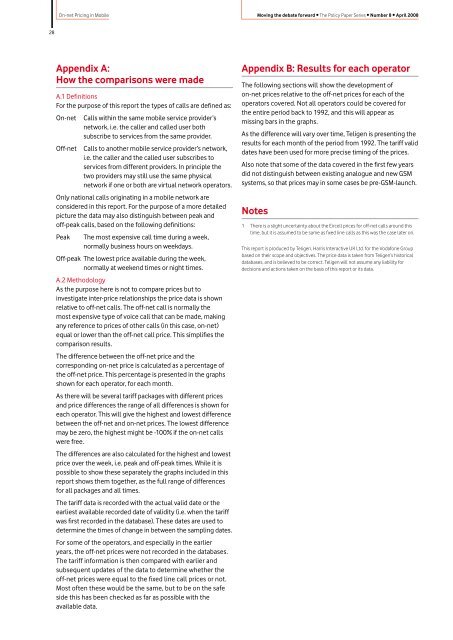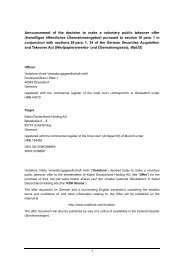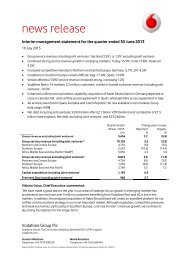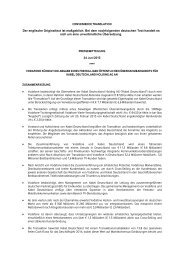Create successful ePaper yourself
Turn your PDF publications into a flip-book with our unique Google optimized e-Paper software.
28<br />
On-net Pricing in Mobile Moving the debate forward • The Policy Paper Series • Number 8 • April 2008<br />
Appendix A:<br />
How the comparisons were made<br />
A.1 Definitions<br />
For the purpose of this report the types of calls are defined as:<br />
On-net Calls within the same mobile service provider’s<br />
network, i.e. the caller and called user both<br />
subscribe to services from the same provider.<br />
Off-net Calls to another mobile service provider’s network,<br />
i.e. the caller and the called user subscribes to<br />
services from different providers. In principle the<br />
two providers may still use the same physical<br />
network if one or both are virtual network operators.<br />
Only national calls originating in a mobile network are<br />
considered in this report. For the purpose of a more detailed<br />
picture the data may also distinguish between peak and<br />
off-peak calls, based on the following definitions:<br />
Peak The most expensive call time during a week,<br />
normally business hours on weekdays.<br />
Off-peak The lowest price available during the week,<br />
normally at weekend times or night times.<br />
A.2 Methodology<br />
As the purpose here is not to compare prices but to<br />
investigate inter-price relationships the price data is shown<br />
relative to off-net calls. The off-net call is normally the<br />
most expensive type of voice call that can be made, making<br />
any reference to prices of other calls (in this case, on-net)<br />
equal or lower than the off-net call price. This simplifies the<br />
comparison results.<br />
The difference between the off-net price and the<br />
corresponding on-net price is calculated as a percentage of<br />
the off-net price. This percentage is presented in the graphs<br />
shown for each operator, for each month.<br />
As there will be several tariff packages with different prices<br />
and price differences the range of all differences is shown for<br />
each operator. This will give the highest and lowest difference<br />
between the off-net and on-net prices. The lowest difference<br />
may be zero, the highest might be -100% if the on-net calls<br />
were free.<br />
The differences are also calculated for the highest and lowest<br />
price over the week, i.e. peak and off-peak times. While it is<br />
possible to show these separately the graphs included in this<br />
report shows them together, as the full range of differences<br />
for all packages and all times.<br />
The tariff data is recorded with the actual valid date or the<br />
earliest available recorded date of validity (i.e. when the tariff<br />
was first recorded in the database). These dates are used to<br />
determine the times of change in between the sampling dates.<br />
For some of the operators, and especially in the earlier<br />
years, the off-net prices were not recorded in the databases.<br />
The tariff information is then compared with earlier and<br />
subsequent updates of the data to determine whether the<br />
off-net prices were equal to the fixed line call prices or not.<br />
Most often these would be the same, but to be on the safe<br />
side this has been checked as far as possible with the<br />
available data.<br />
Appendix B: Results for each operator<br />
The following sections will show the development of<br />
on-net prices relative to the off-net prices for each of the<br />
operators covered. Not all operators could be covered for<br />
the entire period back to 1992, and this will appear as<br />
missing bars in the graphs.<br />
As the difference will vary over time, Teligen is presenting the<br />
results for each month of the period from 1992. The tariff valid<br />
dates have been used for more precise timing of the prices.<br />
Also note that some of the data covered in the first few years<br />
did not distinguish between existing analogue and new GSM<br />
systems, so that prices may in some cases be pre-GSM-launch.<br />
Notes<br />
1 There is a slight uncertainty about the Eircell prices for off-net calls around this<br />
time, but it is assumed to be same as fixed line calls as this was the case later on.<br />
This report is produced by Teligen, Harris Interactive UK Ltd. for the <strong>Vodafone</strong> Group<br />
based on their scope and objectives. The price data is taken from Teligen’s historical<br />
databases, and is believed to be correct. Teligen will not assume any liability for<br />
decisions and actions taken on the basis of this report or its data.

















